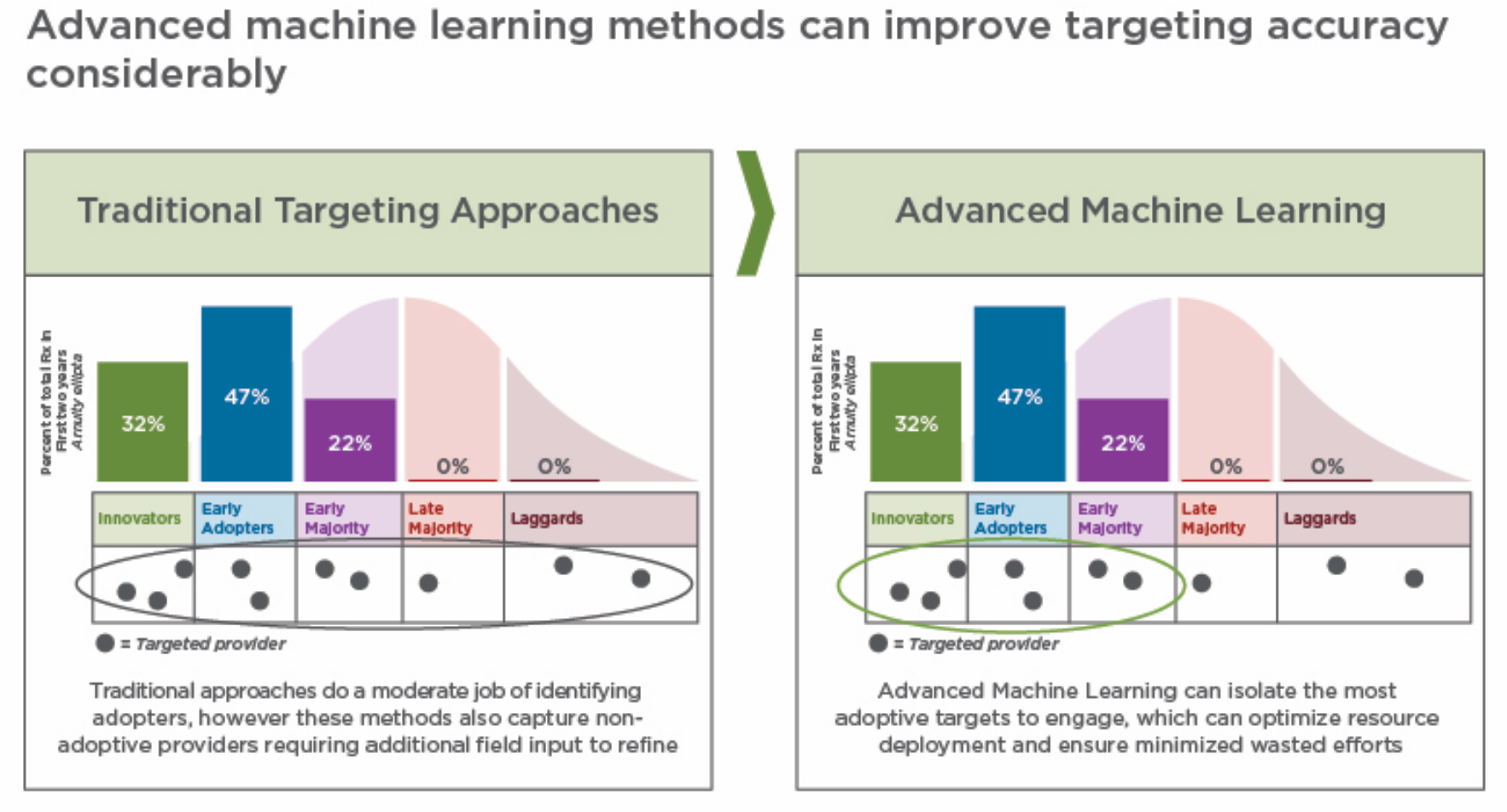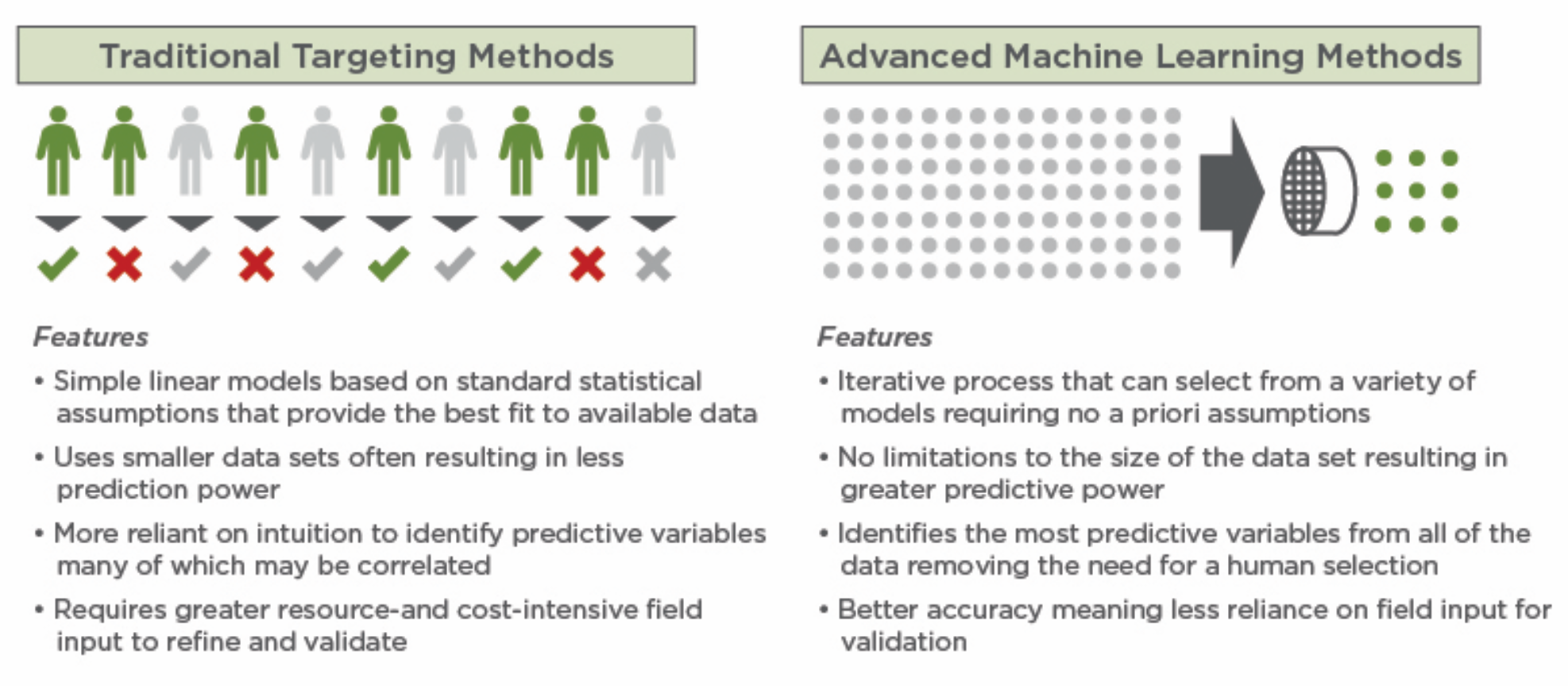How Machine Learning Gives Life Sciences Sales a Competitive Advantage
How machine learning can provide an on-demand portfolio-wide view of optimal provider targeting and related field deployment.
A pharmaceutical company with a cardiovascular therapy wanted to determine which hospitals the treatment option suited best and define their respective stakeholders and influencers to help spur a connection. In the past, like most life sciences companies, the company would have relied heavily on its expertise and best intuition to select analog therapies and proxies for patient volume, such as number of admissions or discharges. In this case, however, the company took a novel approach.
The company took advantage of the increased availability of claims data, abundant computing resources, and machine learning methodologies to precisely identify and determine top-tier hospitals across the United States most likely to adopt and prescribe its new drug therapy. Utilizing the combination of innovative on-point query and analysis design, skilled programming, and industry expertise, the pharmaceutical company gained the critical insights needed to then prioritize these targets based on likelihood of adoption and optimize field resources accordingly.
This article explains how machine learning can provide an on-demand portfolio-wide view of optimal provider targeting and related field deployment. It also explains why life sciences companies should design their field teams to be comprised of individuals who demonstrate agility over singular therapeutic-area expertise.
Traditional vs. machine learning targeting
In practice, traditional sales targeting methods rely on patient volume, analog therapy analysis, and in some cases simple linear models based on standard statistical assumptions that provide the best fit to available data. They also use small data sets and depend on intuition to identify predictive variables, many of which may be correlated, so do not contribute new information. As shown in Figure 1, this traditional approach identifies adopters, but also has been shown to capture non-adoptive providers, which can frustrate the field and create inefficiencies with resource deployment. With this method, opportunities are missed and resources are misplaced.
In comparison, advanced machine learning empowers greater precision, removes the need for manual selection, and minimizes the reliance on field validation, while still allowing for on-the-ground refinements. With no boundary to the size of data sets, these methodologies can draw from all relevant data to demonstrably identify the most predictive variables, isolate the most adoptive targets to engage, and thus enable optimized resource deployment. Machine learning goes far beyond the human capacity. As a result, organizations can also maximize highly adoptive accounts and minimize dead ones.

Figure 1: Traditional vs. Advanced Machine Learning Targeting (click to enlarge)
How Machine Learning Works
A technical term, “machine learning” refers to a very specific type of computer science. In machine learning, the programmer “shows” a machine (or computer) many different examples of whatever is of interest, e.g., emails to identify spam, medical imaging to identify malignancies, or physicians to identify optimal targets. By showing a machine a large number of samples, the machine is able to “learn” how to distinguish the positive records from the negative. This process is the exact opposite of the normal mode of operation, in which people use their own judgement and intuition to manually create an algorithm that they believe will accurately distinguish the positive and negative records.
Machine learning goes far beyond the human intuition capacity. Machine learning ruthlessly iterates millions of combinations of variables to drill down into specific linkages between the therapy option and prescribers, such as procedures performed, prescriptions written, geographic area, hospital affiliations, and physician specialty.

Figure 2: Machine Learning targeting drills down into specific linkages between the therapy option and prescribers (click to enlarge)
Machine learning begins by aggregating all relevant sources from a variety of datasets to construct a comprehensive database of prescribers, including combining prescriptions, analog prescriptions, claims data related to diagnosis and treatment, practice and hospital affiliations, and other physician characteristics for health care provider types of interest.
In a post-product launch scenario, the predictor database is then appended to historical data on our outcome of interest-typically prescription or procedure volume. In a pre-launch scenario, no historical data on utilization is available. In this situation, other mixed-methods, like large-scale quantitative surveys, can be used to identify promising targets.
After assembling the final data set-including predictor and outcome variables-the machine learning model itself is built. The process is both a science and an art in which many different models are attempted using different learners and predictor variable sets. Each model is tested and validated to measure its performance at identifying attractive targets.
Findings are then mapped back to the prescriber universe, assigning each individual physician an Adoption Index Score (AIS). These physicians are then stack-ranked from most likely to adopt to least likely to adopt, and targeting decisions can be made going forward.
The more sophisticated the targeting methodologies used, the better the potential outcome becomes-even an incremental improvement can add significant value.
Large pharmaceutical companies already are leveraging machine learning to improve their targeting accuracy. In one instance, a company used a machine learning-based targeting model to supercharge the launch of a new, high-profile asset. The model produced a more than 50% relative increase in the identification of likely adopters.
In another instance, a company had previously identified a key promotional activity that resulted in dramatic changes in utilization. Machine learning was used to accurately model accounts likely to respond to this specific promotional effort. This approach provided the field team with an optimized list of high-value accounts and clear direction on the tactic to employ when engaging those accounts.
What a modern sales forces looks like
Before the advent of the internet and the increased availability of information, physicians and health care system stakeholders did indeed rely on sales representatives to bring them novel therapies and care insights. Those salespersons who could compliantly provide the most new and relevant information about their products carried a competitive edge. Knowing this, life sciences companies formulated sales teams based on therapeutic areas and valued those representatives who could demonstrate deep disease area expertise. This model was the ideal fit in a time when providers were more dependent on representatives for the latest information. But now in the age of information symmetry, health care providers can access the most current product information on-demand through an ever-growing set of channels. Despite the shifts in information availability and consumption, most life sciences companies continue to build field teams with a value emphasis on depth of product and disease area knowledge.
Beyond the real-time availability of information and increased access to historical claims data, healthcare systems themselves have been reconstructed through consolidation and alignment. Nowadays, while physicians continue to be key influencers, they no longer serve alone as key decisionmakers. Pharmacy and therapeutic (P&T) committees comprised of interdisciplinary professionals-practicing physicians, pharmacists, nurses, administrators, etc.-oversee the review and approval process to determine which new therapy options will be adopted systemwide.
As this new reality continues to emerge and begins to dominate, the traditional sales model based on therapeutic areas of expertise are becoming increasingly ineffective and inefficient.
Rather, to serve the industry in its constant state of transition, life sciences companies that continuously deploy machine learning to understand where opportunities exist across products and therapy areas can look to capitalize quickly. In a market like this, speed gains the competitive advantage. How fast can you get resources to the right places? This means creating dynamic field forces with employees who over-index in the ability to adapt, and who can adjust to new conditions and requirements. Designing teams that are comfortable with shifting priorities and efforts across a wider portfolio can mean getting closer to optimal deployment. Moving to this state means a shift in how industry currently thinks about field teams. They can be viewed as agents serving the company’s overarching objectives for product utilization-not necessarily specific to a brand or a therapeutic area-and comprised of versatile and multipurpose individuals that demonstrate sales agility across markets.
While there are obvious challenges to shifting the field model from one that emphasizes expertise to one that values agility and real-time, perpetually evolving machine learning targeting models can serve as the bedrock to this style of innovative management. With an agile sales force and an ever-more precise list of customer targets, life sciences companies will be better positioned to serve the most patients with the entire therapeutic portfolio.
David Weiss is a director and Bill Woywod a managing consultant both with the Life Sciences Practice at Navigant Consulting.
Is Artificial Intelligence a ‘Product’? Products Liability Implications for AI-Based Products
April 10th 2025As the physical products we use evolve to become increasingly complex, traditional products liability frameworks may not always fit to provide remedies for harm that can result from using novel product types.










